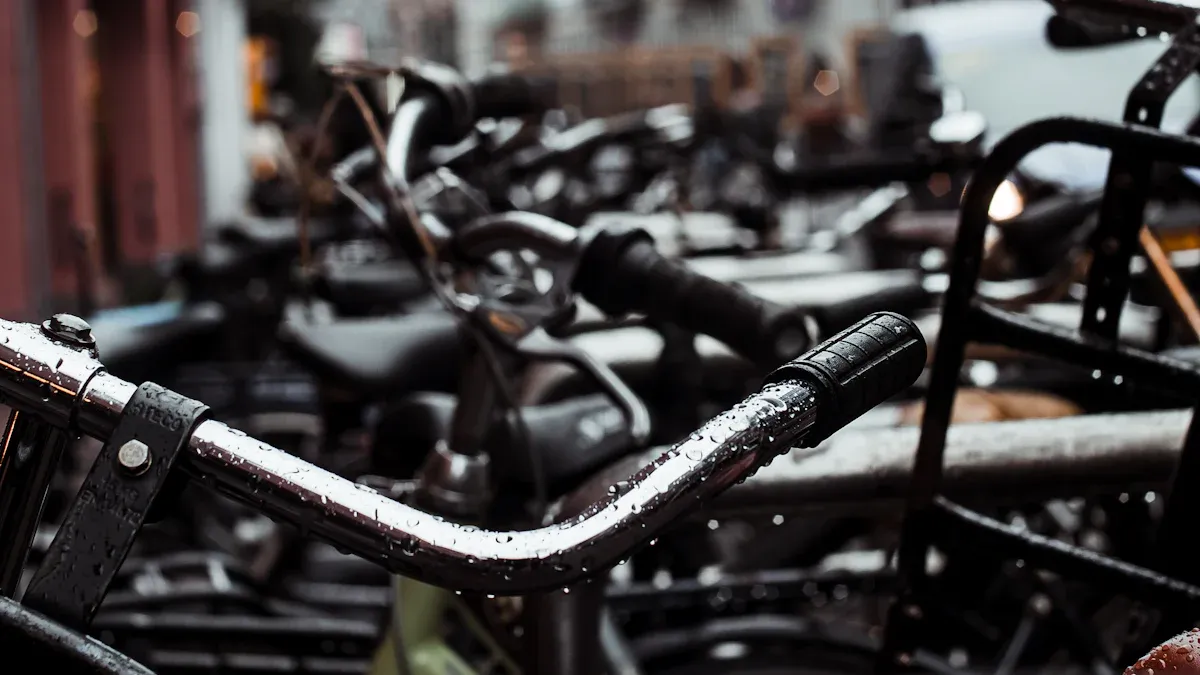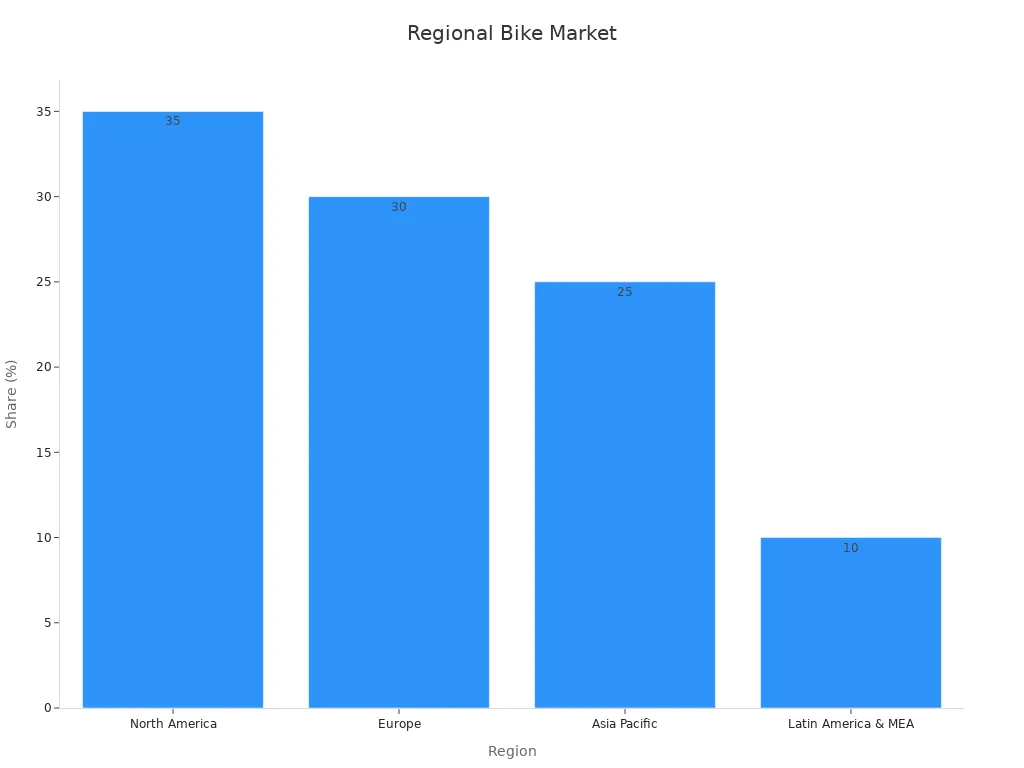
Tracing the Journey of Bike Racks from the 1800s to Today
Tracing bike rack research from the 1800s to now, see how evolving designs and innovations have shaped secure, modern bike parking solutions.

Picture a busy city street where rows of sleek bike racks line the sidewalk, each bike rack offering secure parking for every cyclist. Bike racks started as simple solutions in private sheds or makeshift posts, but today, advanced bike rack designs help support sustainable transportation. Urbanization, security needs, technological progress, and bike rack research have all played roles in this transformation.
Key Takeaways
Bike racks started in the 1800s as simple stands and have evolved to support modern cycling needs.
Urban growth and changing transportation shaped the demand and design of bike racks over time.
Mid-20th century designs improved bike organization and space use, with indoor racks growing fast.
Security became a major focus as bike theft rose, leading to better rack designs and placement.
Smart technology and automated systems now make bike parking safer and more convenient.
Artistic and high-density racks help cities save space and add beauty to public areas.
Research shows cyclists want easy-to-use, secure, and accessible bike racks near key places.
Future bike rack planning relies on data, community input, and policies to support cycling growth.
History of Bike Racks
19th Century Origins
Early Storage Methods
The history of bike racks began in the 19th century, a time when bicycles first became popular. People needed a way to keep their bicycles safe and organized. At first, most cyclists stored their bikes in private sheds, barns, or outbuildings. Some used hitching posts, which were originally made for horses, as makeshift solutions. Businesses that welcomed cyclists sometimes offered simple stands or hooks for parking.
As more people started riding, the need for better bicycle parking grew. The first bike racks appeared as simple metal stands or U-shaped hooks. These early designs were affordable and easy to install. They often showed up in public places like parks, schools, and train stations. The Sheffield rack, a sturdy U-shaped structure, became a popular choice and still appears in cities today. These racks focused on function and durability, but they did not always provide the best security or use space efficiently.
Note: The first bike racks from the 19th century set the stage for future improvements in bicycle parking rack design.
Social and Urban Context
During the late 19th century, cities grew quickly. Urban life changed as more people used bicycles for daily travel. Streets became busier, and the demand for organized bike racks increased. Cyclists wanted safe places to leave their bikes while they worked, shopped, or visited friends. City planners started to notice the need for dedicated bicycle parking, but most solutions remained simple.
The history of bike racks during this era shows how society adapted to new forms of transportation. Early racks helped shape the way people thought about public space and mobility. The presence of bike racks in parks and near train stations made cycling more practical for everyone.
Early 20th Century Changes
Commercial Racks Appear
The early 20th century brought new changes to the history of bike racks. As cycling continued to grow, companies began to produce commercial bike racks. These racks appeared in cities where many people still relied on bicycles. The first bike racks in this period included metal wheel slots, vertical posts, and wall-mounted hooks. Businesses and schools installed these racks to help manage the growing number of bicycles.
Bike racks became more common in public spaces. They offered a simple way to keep bikes upright and organized. Although these racks improved convenience, they still had limits in terms of security and space.
Impact of Automobiles
The rise of the automobile changed the history of bike racks and bicycle parking. As cars became more popular, cities focused on building roads and parking lots for vehicles. Bike racks and other cycling infrastructure received less attention. In many places, the number of bike racks declined as urban planners prioritized cars.
Despite this shift, some cities in Europe continued to support cycling. They kept installing bike racks and maintained bicycle parking areas. Over time, interest in cycling and bike racks returned, especially as people looked for healthier and more sustainable ways to travel.
The history of bike racks reflects changes in society, technology, and urban planning. From the early designs of the 19th century to the commercial racks of the 20th century, each step shaped the way people use and think about bicycles today.
Evolution in Design and Function
Mid-20th Century Developments
Functional Focus
During the mid-20th century, bike racks shifted from basic stands to more functional solutions. Designers started to focus on how racks could hold bikes upright, save space, and make parking easier for everyone. The “schoolyard” rack became a common sight. This design used parallel bars, allowing several bikes to park side by side. Another popular style, the “toast” rack, featured vertical dividers that kept bikes separated and organized. These new bike rack designs helped schools, parks, and businesses manage growing numbers of bicycles.
Bike racks also began to appear in more locations, reflecting the rise in bike commuting. As more people chose bicycles for daily travel, the demand for better parking increased. The market for indoor bike racks grew rapidly, with a projected value of USD 300 million by 2033. Wall-mounted racks held a 40% market share in 2023, and ceiling-mounted racks became the fastest-growing segment. Home use led the market, driven by indoor cycling and fitness trends.
Statistical Trend / Market Insight | Data / Description |
|---|---|
Increase in bike commuting (U.S.) | 60% rise from 2000 to 2018 (U.S. Department of Transportation) |
Market size (Indoor Bike Racks) | USD 150 million in 2024 projected to USD 300 million by 2033 |
Market CAGR (2026-2033) | 8.5% |
Ceiling-mounted bike racks growth | Fastest growing sub-segment with CAGR of 8% |
Wall-mounted bike racks market share (2023) | 40% market share, horizontal style dominates with 55% within this segment |
Home use market share (2023) | 60% of market share |
Commercial use market share (2023) | 40% of market share |
Fastest growing application segment | Home use, driven by indoor cycling and home fitness trends |
Urbanization and government initiatives | Promote cycling infrastructure, increasing demand for secure and functional bike racks |
Innovations in bike racks | Integration of theft prevention technology, tracking, smart and customizable designs |
Regional market shares (2023) | North America 35%, Europe 30%, Asia Pacific 25%, Latin America & MEA 10% |
Market drivers | Rising cycling popularity, health benefits, sustainable transport, government support |
Market opportunities | Emerging economies, tech integration, customizable options |

Standardization
As bike racks became more common, cities and organizations recognized the need for standard designs. Standardization made it easier to install racks in public spaces and ensured that most bikes would fit securely. The Sheffield rack, a simple U-shaped metal bar, became a standard in many cities. This design allowed cyclists to lock both the frame and the wheel, improving security and convenience.
Standardized bike racks also helped urban planners create organized parking areas. These racks supported the growing trend of cycling for commuting and recreation. Manufacturers responded by offering racks in different sizes and materials, making it easier for schools, businesses, and cities to choose the right solution.
Security and Urban Integration
Theft Concerns
As more people used bicycles, theft became a serious problem. Bike rack designs had to adapt to keep bikes safe in busy urban areas. Research on bikesharing systems shows that theft and vandalism pushed designers to create more secure bicycle storage options. Cities around the world, including Sweden, found that secure bike racks encouraged people to combine cycling with public transit. This approach, known as “bike and ride,” made cycling more attractive and practical.
Urban features such as car parks, subway stations, and shops often saw higher rates of bicycle theft. Studies from cities like Washington DC, London, and Shanghai revealed that theft risks increased in areas with dense bike parking or high pedestrian traffic. Social factors, including neighborhood poverty and migrant populations, also played a role in theft rates.
Urban Feature / Factor | Impact on Bicycle Theft | Geographic Context / Study Reference |
|---|---|---|
Car parks | Positively associated; provide continuous targets for theft | Lagos, Nigeria; Louisville, USA |
Subway stations | Positively associated with bike theft due to dense bike parking | Washington DC; Seattle, USA |
Bus stops | Positively associated with bicycle theft | Seattle, USA |
Shops (including convenience stores) | Attract offenders due to high pedestrian traffic; considered ‘hunting grounds’ | Various US studies |
Train stations | Positively associated with increased bicycle theft | London, UK |
Socially disadvantaged populations | Higher theft risk linked to areas with more socially disadvantaged individuals | Seattle, USA; Tianjin, China |
Migrant population proportion | Positively associated with bicycle theft | Shanghai, China |
Neighborhood poverty and crime levels | Risk factors for bicycle theft | Tianjin, China |
Note: Secure bicycle storage and improved bike rack designs have become essential in reducing theft and supporting cycling as a reliable mode of transport.
Urban Planning Shifts
Urban planning began to integrate bike racks into the design of streets, parks, and transit stations. Planners recognized that convenient and secure parking encouraged more people to ride. Cities invested in racks near bus stops, train stations, and shopping areas. This integration made cycling a practical choice for daily travel.
Government initiatives and urbanization fueled the demand for better bike racks. Planners worked to balance the needs of cyclists with other users of public space. Innovations such as theft prevention technology and smart racks appeared in response to these challenges. The evolution in design and function of bike racks reflects how cities adapt to changing transportation needs.
Tip: When cities include bike racks in urban planning, they help create safer, more sustainable communities.
Modern Innovations in Bike Racks

Technology Integration
Smart Systems
Cities now use technology to make bike rack systems more secure and convenient. Smart bike racks use sensors, cameras, and electronic locks. These features help cyclists find available spaces and keep their bikes safe. Some systems connect to mobile apps, allowing users to reserve a spot or check real-time availability. Cities like Tokyo and Amsterdam have adopted these smart systems to manage large numbers of bicycles. Smart bike racks also collect data on usage patterns, which helps city planners improve cycling infrastructure.
Note: Smart systems can reduce theft and make cycling more attractive for daily commuters.
Automated Parking
Automated bike rack solutions have changed the way people park their bikes in crowded cities. These systems use lifts, conveyors, or rotating platforms to store bikes in multi-level structures. Cyclists place their bikes in a loading bay, and the system moves the bike to a secure spot. This method saves space and protects bikes from weather and theft. Japan leads in automated parking, with underground towers that can store hundreds of bicycles in a small area. Automated bike rack systems often appear near train stations and busy shopping districts.
Design Diversity
Artistic and Specialized Racks
Modern bike rack designs go beyond simple function. Many cities install racks that double as public art. These racks use creative shapes, colors, and materials to add character to streets and parks. Some bike racks look like animals, letters, or abstract sculptures. Artistic racks encourage cycling by making public spaces more inviting. Specialized racks also meet the needs of different bikes, such as cargo bikes or e-bikes. These racks offer extra support and charging options for electric models.
Examples of specialized bike rack features:
Wider slots for cargo bikes
Integrated charging ports for e-bikes
Adjustable arms for different frame sizes
High-Density Solutions
Urban areas need bike racks that can hold many bikes in a small space. High-density solutions include double-decker racks and vertical storage systems. These designs let cyclists park bikes above or below each other, making the most of limited space. Some high-density racks use sliding or folding mechanisms for easy access. Schools, transit stations, and office buildings often choose these systems to serve many users. High-density bike rack options help cities support more cyclists without taking up extra room.
Tip: High-density and artistic bike racks show how design can solve real-world problems while making cities more beautiful.
Bike Rack Research and Trends
Research-Informed Design
User Preferences
Bike rack research has shown that user preferences play a major role in shaping modern bicycle parking solutions. Surveys and interviews with cyclists reveal that people want bike racks that are easy to use, close to their destinations, and offer strong security. For example, a study from the University of California Transportation Center found that building owners and managers often choose bike racks based on operational needs and a desire to promote a green image. However, many decisions happen without clear guidelines, which highlights the need for more structured bike rack research.
Researchers at the University of Iowa have also studied how cyclists interact with bike racks and other infrastructure. Their work shows that riders value protected parking and feel safer when racks are placed in visible, well-lit areas. Interviews with potential cyclists reveal that the lack of accessible and secure parking can discourage people from riding. These findings support the idea that bike rack research should focus on real-world user experiences to guide future improvements.
Security and Accessibility
Security and accessibility remain top concerns in bike rack research. Cyclists often worry about theft, especially in busy urban areas. Studies show that racks designed to secure both the frame and wheels help reduce theft and increase rider confidence. Accessibility also matters. Cyclists prefer racks that are easy to reach and do not require lifting heavy bikes. Research highlights the importance of placing racks near entrances, transit stops, and popular destinations.
Bike rack research also points to the need for racks that serve a wide range of users, including those with cargo bikes or e-bikes. As cities grow and cycling becomes more popular, planners must consider how to make bike parking safe and convenient for everyone.
Emerging Trends
Micromobility Integration
Recent bike rack research highlights the growing influence of micromobility on parking infrastructure. Cities now see more e-bikes, cargo bikes, and scooters, each with unique parking needs. Market studies show that the rise of e-bikes drives demand for racks with larger slots and charging stations. Bike-sharing programs also require dedicated parking areas to support shared mobility and reduce clutter.
Trend/Factor | Description | Implication for Bike Rack Design and Sustainability |
|---|---|---|
Higher density encourages bikesharing and sustainable travel choices | Future racks will prioritize compact, high-capacity solutions | |
AI and Smart Technologies | Use of AI for parking compliance and defect detection | Smart racks will optimize space and reduce improper parking |
Vehicle Evolution | E-bikes and cargo bikes need durable, specialized racks | Racks will adapt to support diverse micromobility vehicles |
Sustainability Goals | Focus on reducing emissions and supporting cargo bike deliveries | Racks will align with environmental and urban freight objectives |
Infrastructure Surveys | Agencies adapt to changing micromobility needs post-pandemic | Bike rack research will guide flexible, user-centered infrastructure |
Micromobility vehicles now feature advanced technology, such as AI-enabled parking detection and anti-lock brakes. Cargo bikes are replacing delivery trucks for last-mile logistics, which means racks must support heavier and larger bikes. This shift underlines the importance of adaptable, sustainable bike rack designs.
Sustainability
Sustainability stands at the center of current bike rack research and innovation. Urban planners and policymakers aim to reduce emissions and promote cycling as a green alternative to driving. Many cities, like New York, include bike racks in their sustainability and transportation strategies. Solar-powered racks and modular designs offer eco-friendly and flexible solutions.
Consumer behavior studies show that environmental consciousness influences bike rack purchases. People want racks that support a cleaner city and align with social values. Companies now design racks that meet environmental, social, and governance (ESG) criteria. As urbanization continues, bike rack research will remain vital in guiding sustainable growth and supporting the shift toward shared, low-speed transportation options.
Challenges and Future Directions
Current Issues
Supply and Demand
The bike rack sector faces several challenges as cities and communities work to expand cycling infrastructure. Demand for bike racks continues to rise, fueled by urbanization, government support, and the growing popularity of cycling. However, supply often struggles to keep pace. High costs for infrastructure, limited budgets, and competing priorities make it difficult for many cities to invest in enough bike racks. Environmental concerns also play a role, as communities seek sustainable materials and solutions that do not harm the planet.
Major challenges in the bike rack sector include:
Pressure to balance cost-effectiveness with sustainability
Fragmented and competitive market with diverse consumer needs
Regional growth differences, with Asia Pacific facing rapid urbanization and supply challenges
The need to adapt to both online and offline distribution channels
Despite these obstacles, the market continues to expand. Innovation and customization help meet the needs of different users, but financial and environmental factors remain significant hurdles. Cities must find ways to invest in infrastructure while addressing sustainability and cost concerns.
Security Gaps
Security remains a pressing issue for bike rack systems, especially in urban environments. Many cyclists worry about theft, which can discourage people from choosing bikes for daily travel. Studies show that areas with dense bike parking, such as subway stations and shopping centers, often experience higher rates of bicycle theft. Socio-economic factors, including neighborhood poverty and population changes, can also increase risks.
A comprehensive analysis of bike-sharing systems in cities around the world highlights additional concerns. Uneven distribution of bike stations and limited integration with other transit options create barriers for many users. Accessibility and equity issues persist, with some communities lacking safe and convenient bike parking. These gaps show the need for more inclusive planning and better security measures.
Future Prospects
Data-Driven Planning
Looking ahead, data-driven planning offers promising solutions for bike rack challenges. Cities can use advanced models to forecast demand, optimize station locations, and manage fleets more efficiently. For example, mathematical models applied in Vienna help planners predict where bike racks are needed most and ensure long-term system effectiveness. Real-time data from smart bike racks and bike-sharing programs can guide decisions about placement and capacity.
Planners who use data can respond quickly to changing needs and improve the cycling experience for everyone.
Policy and Community Roles
Policy and community involvement will shape the future of bike rack infrastructure. Governments play a key role by setting standards, providing funding, and promoting cycling-friendly policies. Community input ensures that bike rack solutions meet local needs and address equity concerns. Inclusive infrastructure development can help close gaps in access and make cycling a practical choice for more people.
Key actions for future progress:
Invest in sustainable and secure bike rack designs
Use data to guide infrastructure planning
Involve communities in decision-making
Promote policies that support cycling and equity
By focusing on these strategies, cities can overcome current challenges and build a more accessible, secure, and sustainable future for cyclists.
Bike racks have evolved from simple storage in sheds to advanced, research-driven infrastructure that shapes city life. Modern bike infrastructure, as seen in cities like Copenhagen, supports sustainable urban mobility and encourages healthy, active travel. Studies show that well-designed cycling facilities bring social, environmental, and economic benefits. Ongoing innovation and research will continue to improve bike parking. Readers can reflect on how these changes affect their own communities and imagine the future of cycling.
FAQ
What is the main purpose of a bike rack?
A bike rack provides a secure place for cyclists to park and lock their bicycles. It helps prevent theft and keeps bikes organized in public and private spaces.
How have bike rack designs changed over time?
Designs have evolved from simple metal stands to advanced systems with security features, smart technology, and artistic elements. Modern racks support different bike types and fit into urban environments.
Why do cities invest in bike racks?
Cities install bike racks to encourage cycling, reduce traffic congestion, and support sustainable transportation. Bike racks make it easier for people to choose bicycles for daily travel.
What features make a bike rack secure?
Secure bike racks allow cyclists to lock both the frame and wheels. Some racks include electronic locks, surveillance cameras, or are placed in well-lit, visible areas to deter theft.
Are there bike racks for electric bikes and cargo bikes?
Yes, many new racks accommodate e-bikes and cargo bikes. These racks offer wider slots, extra support, and sometimes charging ports for electric models.
How do smart bike racks work?
Smart bike racks use sensors, electronic locks, and mobile apps. Cyclists can check availability, reserve spots, and receive alerts. These systems help manage parking and improve security.
What trends shape the future of bike racks?
Emerging trends include integration with micromobility, sustainable materials, and data-driven planning. Cities focus on racks that support e-bikes, cargo bikes, and shared mobility solutions.
Tip: Choosing the right bike rack improves safety and encourages more people to cycle.


